Usually, a review of the materials for the facade in order to sheathe a wooden house from the outside is carried out at the design stage. Specific material is determined taking into account the climatic conditions of the region and the general style of construction. The basis for the selection of suitable finishes is a combination of decorativeness and protective characteristics. After the list of options has been reduced to 2-5, they decide which one is best in a particular situation based on technical and monetary capabilities.
Content
Why does a wooden house need cladding
A wooden house is an environmentally friendly and convenient construction facility, the construction technology of which is simple. But, wood is not the most wear-resistant material without additional protection from the influence of external factors. Wooden parts of the structure absorb moisture and accumulate it inside. The result of water absorption, the influence of ultraviolet and oxygen are such negative changes:
- decrease in density;
- darkening of color;
- mold development;
- sprawling moss;
- rotting and destruction of the material.
To protect the material from the effects of atmospheric phenomena and pests, it is necessary to apply chemicals - varnishes, stains, impregnations, paints. In addition, it is possible to cover the walls with other building materials - siding, lining, plaster. But, treatment with chemical protective drugs is needed even in these cases. This procedure will enhance the heat-insulating and water-repellent characteristics of a house made of wood and increase its appearance-like qualities.
When selecting a specific variant of the casing, there are a number of rules that govern its physical and technological properties.
The ratio of "price-quality" when selecting material for lining
When choosing a particular option, the degree of vapor permeability of the material is carefully considered, since the tree should "breathe". It is impossible to carry out hermetic home decoration - you need to save gas exchange. In addition, the vapor permeability of the finishing agent should be higher than that of the solid wall. This contributes to the release of excess moisture outside, and not inside the structure.
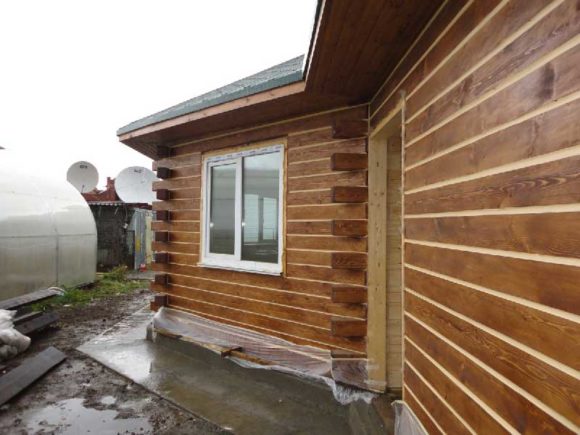
When the vapor permeability rule is not respected, excess water is collected at the line of contact between the wood and the casing. This leads to a zone of increased humidity. This area is excellent conditions for the development of mold, rot and other phenomena that adversely affect the structure of natural material. At minus temperatures, when there is a lot of water in the zone of increased humidity, it freezes and expands, which can lead to deterioration of the facing material.
When a wooden structure is sheathed with a vapor-tight building material, it is necessary to carry out a ventilated facade. This design implies that the outer relatively or completely vapor-tight layer is located at a distance of 60-150 mm from the tree. Above and below retain holes - for the natural circulation of air, and the excess water leaves with convection flows. The options for cladding are selected depending on the type of wood processing:
- Log houses need cladding, although many think otherwise. They finish the walls to protect the tree and so that the structure does not sag. Finishing is especially important when a log is used.In this case, it is better to sheathe a wooden house from the outside with a euroboard or lining.
- SIP panels - PVC panels and siding are suitable for decoration. Lining and euro board are not the best options.
- Bar - it is permissible to sheathe such houses with any material. But, it is recommended not to use natural stone or facing tiles for decoration - the timber will decay, and it will be damp in the house.
- Wireframe - you need lightweight material. A rounded board (block house), lining fit. A good option is siding. Can be trimmed with other plastic or wood panels. But, they do not recommend the use of fire-hazardous plastic, since the structure's low fire resistance also decreases.
Sheathing a wooden house is necessary - to prevent premature degradation of the material. Sheathing reduces the cost of regular wood treatment with protective preparations.
Wood cladding
The wooden house can be sheathed outside with various building materials. Including it is permissible to make wood cladding. The use of natural finishing material is a good option for structures made of logs, structures made of timber and frame structures. The most common facing building materials made of natural wood are as follows:
- block house;
- lining;
- planken;
- imitation of a bar.
These finishing materials have significant advantages over plastic, stone and plastering wooden walls. Nevertheless, these groups of building materials retain all the disadvantages that are characteristic of wood. Because of this, periodic treatment of the sheathed walls of a wooden house with antiseptic agents, paints and top coat varnishes will be necessary.
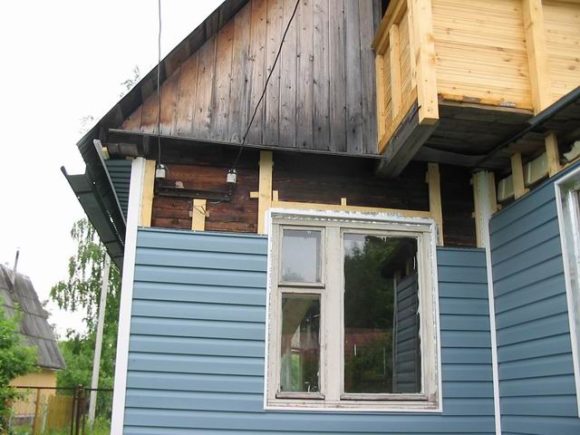
Lining
Wooden clapboard retains the natural appearance characteristics of a house made of natural material. But, such a lining improves the functional parameters and aesthetics of the structure. Lining is a flat board that is easy to fix. Such boards can be easily docked longitudinally with adjacent elements using specialized spikes.
Lining is a building material, which is completely environmentally friendly, has high strength values, heat-insulating and noise-suppressing properties. But, such a finish has a minus - some vulnerability to pests. This problem is solved by treatment with specialized protective preparations. In addition to the indicated, the lining should be tinted - approximately once every three years.
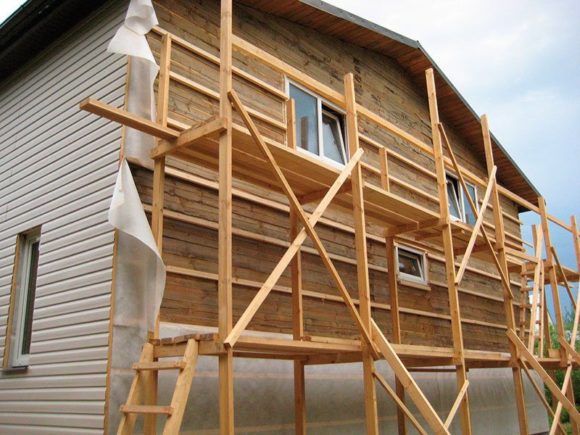
Imitation of a bar
This building material, as well as lining, forms a prefabricated surface. But, the appearance of this surface has some differences. The imitation of the beam is fixed horizontally, but it is difficult to notice the joints. After the fastening is completed, the view of the wall of the building corresponds to the surface made of profiled timber. This cladding is made of natural wood:
- cedar;
- pine trees;
- ate;
- larch trees.
These types of wood are used for the manufacture of imitation timber because of the high resinity, which extends the life of the simulation.
The material has the form of boards, the length of which is from 2 to 4 m. The thickness of each element is 2-35 mm, and the width is 105-175 mm. It is possible to buy a spliced board, which is assembled from narrow rails or whole - from one log. Both options in terms of service life and other parameters do not actually differ. The positive and negative sides of the imitation of the beam are the same as that of the lining. But, this finishing material has a great decorative effect.
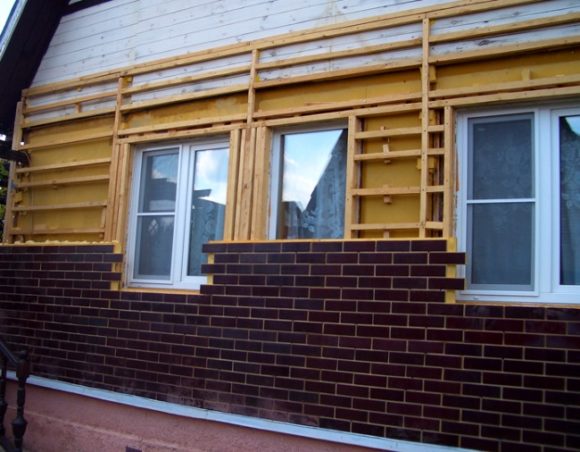
Block house
A rounded board, otherwise - a block house, essentially one of the varieties of wooden lining. Such finishing material is made exclusively from coniferous trees, since high resinity increases the service life of the rounded board. The main distinguishing feature of the wooden lining at the block of the house is the shape. Finishing material imitates a cylindrical log. The inside of the rounded board is flat, which makes fasteners easier. The block house is fixed using the thorn-groove technology.
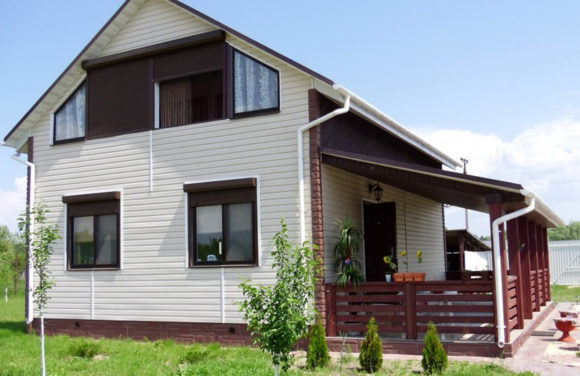
A rounded board is a modern material, which, in comparison with a standard lining, has some characteristics. Block house has a higher value of protection against pests and the influence of atmospheric phenomena. However, a significant negative point in the use of a rounded board for finishing wooden houses is the high price.
Planken
Relatively new material. Planck is made in the form of a facade board, in which the sides are rounded or beveled. This facing material is produced either from resinous wood species (larch, pine), or from polymer-wood raw materials. The width of the planken is 70-140 mm, and the thickness is from 15 to 20 mm. The bevel angle of the faces is also different, but it is made in the range of 45-70-.
Most often used planken for ventilated facades. Before sale, this material is treated with flame retardants - to increase refractoriness, and antiseptic compounds. In most cases, planken is impregnated with environmentally friendly drugs, but in order to buy high-quality building materials, it is recommended to check the certificates. In addition, you need to pay attention to the price of planken - sometimes cheap can be saturated with toxic reagents.
They fix the planken with an overlap either according to the "thorn-groove" system.
Siding
Quite often, building materials for cladding wooden houses made from natural raw materials are expensive and not always available. When there is a serious restriction on money and the owner is looking for how to sheathe a house from the outside cheaply and beautifully, siding is a good option. This building material does not need subsequent maintenance, unlike wooden finishes. Any lining made of natural material should be periodically treated with flame retardants, paints and antiseptics.
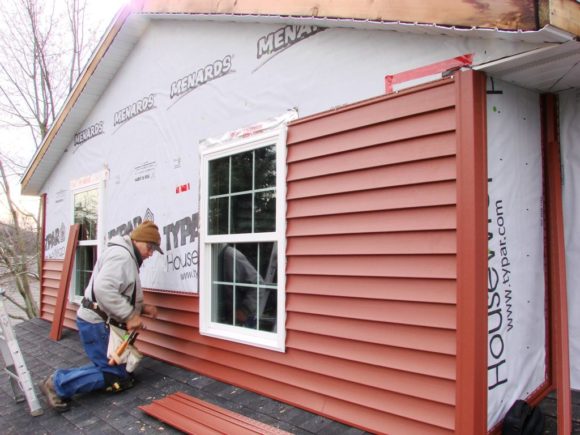
The siding needs installation of a lathing. This circumstance leads to the fact that, as a result, the facade goes ventilated. Such building materials can be used in the case of wooden structures made of logs, beams or shields. In addition, there are no restrictions for wall decoration on the outside and in the case of aerated concrete, foam concrete, slag-filling, brick and other structures.
Polyvinyl chloride
PVC, otherwise - polyvinyl chloride, the raw material from which siding is often made. This kind is also called vinyl. They are made in the form of strips, the width of which is 255 and 205 mm. The thickness of one element of vinyl siding is 1.1 mm and 1.2 mm. In length on the strip there are perforations for fasteners on one side, and a lock on the other. Fasten siding to the crate. For this frame, it is recommended to use a specialized metal profile, but wooden bars are also suitable. But, more often vinyl siding is fixed using self-tapping screws. But then you need to leave some clearance - to compensate for temperature changes in materials. If you do not leave a backlash, then the vinyl siding will crack due to the emerging stress of the material.
The vinyl version has many positive aspects. The main advantages of its use are low price, ease of mounting. But, there are also negative sides. The main disadvantage is that the material loses color relatively quickly under the influence of ultraviolet radiation. Because of this, it is recommended to use soft tones. In addition, despite the wide possibilities of operation at different temperatures (-35 ... + 50̊ С), even with a slight minus it becomes fragile on the street. Vinyl siding in frost is easily damaged in the event of mechanical stress.
Vinyl siding looks good in the case of wooden houses of complex construction. But, when the box of the building is just rectangular, the view is rustic.
Metal
Metal siding is a metal strip made of thin galvanized steel or aluminum. A decorative protective layer is applied to them. The fastening system is no different from that provided for vinyl siding.The upper decorative protective coating is often made of polymers, but sometimes powder coating is also used. The latter has more options for tones, while the paint does not peel off over time, given the fact that the main negative side of metal siding is enclosed in a limited palette.
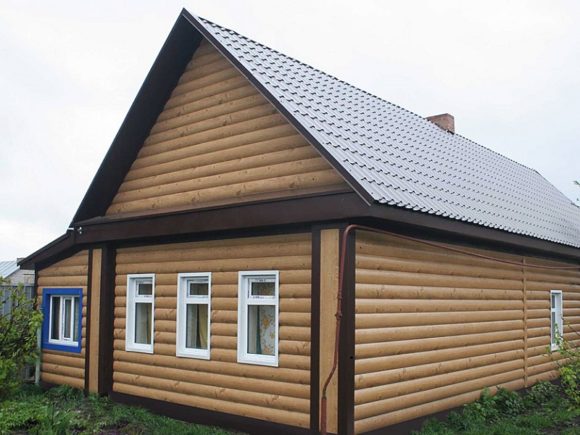
Unlike vinyl siding, the color of the metal does not actually fade under the influence of ultraviolet rays. Using such metal strips, you can make a wooden house bright, while the reliability of this siding is higher. Metal elements can be bent, but breaking them is hard. At the same time, it is simple to fix them - just scissors for metal, a screwdriver or a screwdriver and screws. The metal siding option is not bad, since the service life is longer than that of vinyl. But, the final view is not to all owners' liking, since the structure has a great resemblance to a warehouse or workshop than to a residential building.
Basement
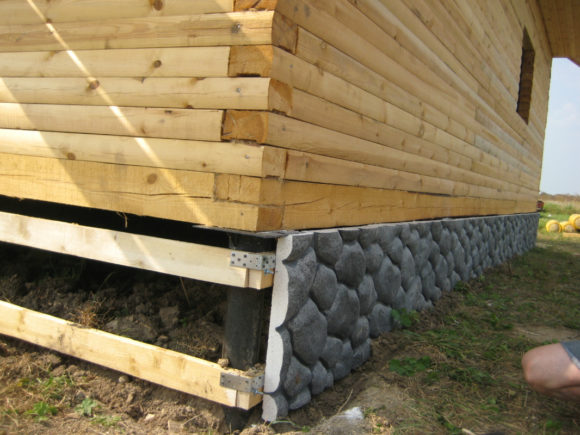
One of the types of vinyl siding, but a completely different configuration. The basement version has a large thickness and a different type of panel. Such cladding was designed directly to protect and decorate the plinths of structures. But, basement siding allows you to get an interesting result, and it began to be used for residential buildings. The design is different in color and appearance:
- On individual elements of the basement siding can be printed.
- Some types are made monophonic, sometimes they are used in combination with plates with an ornament.
- There is basement siding, decorated under a wild stone. Often, without close examination, it is impossible to distinguish imitation from natural material.
Because of the curly edges, the crate needs to be adjusted to separate elements of the basement siding.
Base siding, like other types, is fastened to the crate. But, the panels of this finishing building material are not in the form of elongated rectangles, but in a certain section of the wall of curly shape. Such edges are the junction. During installation, one edge is first brought into the lock of the already fixed panel and only then finally fixed. Basement siding, like vinyl, needs backlash - to prevent excessive stress on the material. The lathing for basement siding can be made of wood blocks treated with special solutions. It is also permissible to use a galvanized metal profile for drywall.
Alternative finishes
Some cladding building materials that can be used in the case of wooden buildings have protection against ultraviolet radiation, moisture and mechanical damage. But, such cladding does not always increase heat-insulating and sound-absorbing parameters. The energy efficiency of the casing is increased in the presence of a layer of thermal insulation material:
- penoplex;
- mineral wool;
- polystyrene.
The insulation is placed in the voids that are left between the wall and the skin during the fastening of the latter. Sometimes the insulation is already present on the installed elements, for example - in the case of sandwich panels. But, besides them, there are other, less common materials that can be used to sheathe the walls of wooden residential buildings from the outside.
Fiber cement siding
Fiber cement boards are a relatively new type of cladding. Siding is also made of the same material. The raw materials are formed into sheets that are dehydrated in several stages. Some manufacturers perform firing - depending on the composition of the fiber cement elements. Basically, the material of fiber cement siding, before undergoing dehydration and firing, is made from such initial raw materials:
- quartz;
- wood fiber;
- cement;
- mica;
- asbestos;
- chlorine.
A decorative protective layer is applied to the surface of the finished plate. In the case of inexpensive fiber cement siding, this is acrylic. The average price of cladding in the case of photoceramic coating.But, the most resistant to fading and abrasion is a hybrid-ceramic decorative protective layer. Such fiber cement siding is expensive. The coating is smooth - matte and glossy or imitates wood, brick and more.
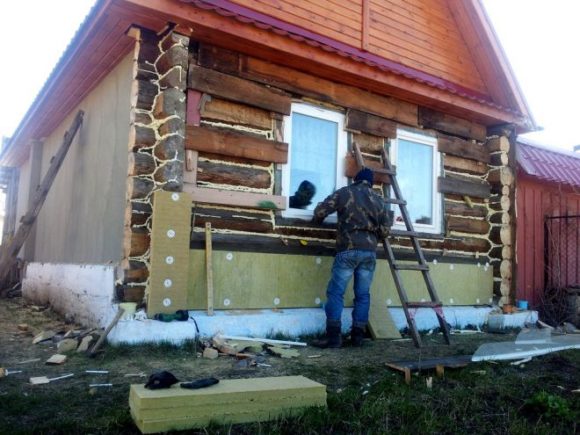
Attach to mounting rails using kleimers. The final casing is tight, moisture does not get inside. The strips often have a standard size - 3600x190x12 mm.
Thermal panels
Thermal panels are a ready-made solution that will help not only to ennoble the facade of the building, but also to insulate the walls. In the production of the material, a decorative coating of PVC is applied to the heat insulator, which may look like natural or artificial stone. The insulation and resistance qualities are distinguished by the heat insulator at the base. In the role of the base fabric are such insulation:
- Styrofoam;
- mineral wool;
- polystyrene foam.
The installation procedure for different heaters is also different in the basis - for polystyrene foam and polystyrene, adhesive compositions are needed, and basalt thermal panels are attached to the profile system. The joints between the individual plates are covered with aluminum strips or rubbed with paste. Other installation features are also determined by the type of substrate. There are also clinker types of panels - clinker tiles are glued on top of the insulation.
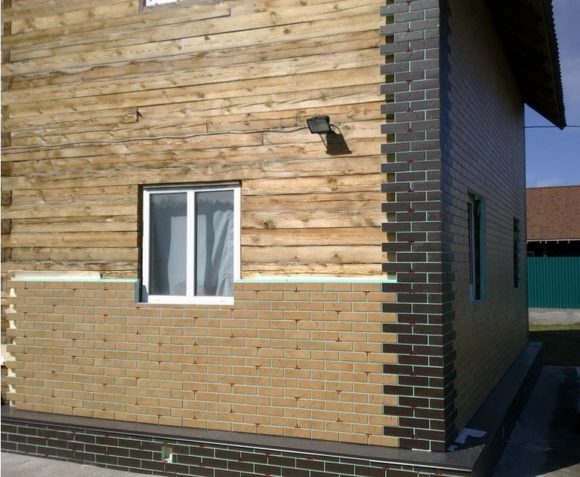
Tile and brick cladding
The old facade of a wooden house can be inexpensively faced with brick, tile or decorative stone. Such materials in the decoration imitate the structure of stone and brick buildings. Brickwork on top of the main facade can fix common geometric irregularities. Such could be allowed during construction or arise during operation due to soil displacement or after replacing logs (timber). The advantages of brick and structural materials similar to the structure for the facade coating of houses are as follows:
- Prevalence at low cost compared to most similar materials.
- Low water absorption, which ensures the preservation of heat and protection of the main wall of the house.
- Resistance to seasonal changes in temperature indicators, both cyclical and sharp.
- The high level of noise reduction and the duration of the operation period is about 20 years.
Between the new facade coating and the main wall of the building, heaters based on basalt wool, extruded polystyrene foam or foam boards are often laid.
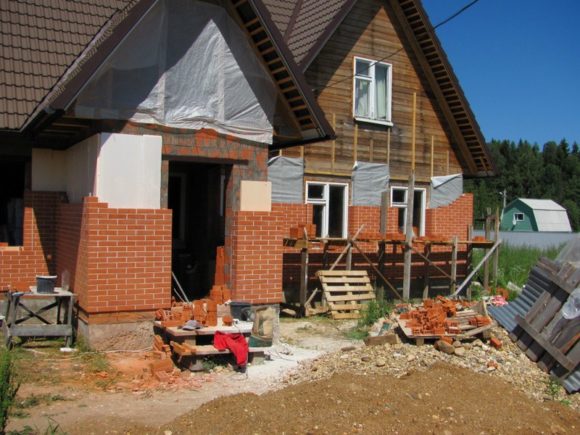
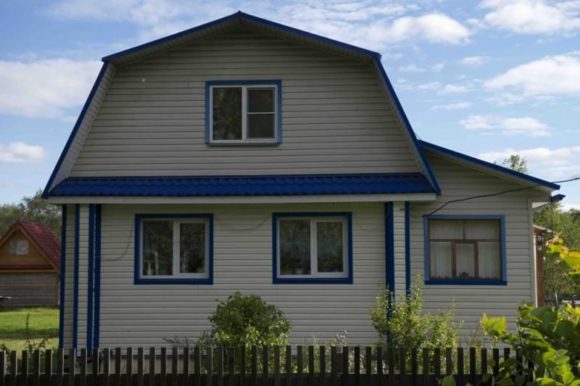
If the walls are weak, it is possible to brick the building. But, before starting the finishing work, it is necessary to prepare the foundation for the coating, since it has a larger mass than lumber or vinyl siding. To do this, they dig a trench around the perimeter of the building, fill it with rubble and lay the blocks on the pillow. On top, you can make a cement screed and raise the primary layer of brick. Next, do the masonry on cement mortar with a gap from a wooden wall.
Profiled Sheets
Profiled sheet - material for facades, which are made on the basis of galvanized steel sheet with a protective coating of polymers. The main scope of its application is the wall decoration of industrial and technical structures. But, due to the design change in the structure of the coating and the material itself, you can use a professional sheet with imitation of natural stone and wood. Of the positive aspects distinguish:
- High resistance to natural influences - practically not afraid of water, not subject to temperature changes and does not pass wind.
- Easy to install - the dimensions of each sheet allow you to quickly make installation.
- Fire resistance - the metal at the base is not subject to fire, only a surface coating can burn.
The main drawback of the profiled sheet is the vapor tightness due to which condensate accumulates, which leads to the debate of the main material and the development of molds. Therefore, it cannot be used on facades without preliminary preparation of ventilation of the intermediate space.To do this, leave a gap between the main wall of the house and the facade. The second drawback is bending with significant mechanical pressure or impact. It will not be possible to completely align and smooth the bends and dents on the profiled sheet - you need to mask or replace the damaged sheet.
It is better to buy corrugated sheets after preliminary measurement of the wall plane and to calculate the material with a margin for expansion and contraction with temperature fluctuations in the seasons.
Reviews
To choose good materials for the external coating of the facade of a wooden house, it is recommended to pay attention not only to the characteristics and properties specified by the manufacturer. To conduct a comparative characteristic for certain types of coatings without experience of interaction with them will fail. Before buying, it is better to read the reviews of those people who have already performed the exterior decoration of a wooden house:
Valery Blazhenov, 38 years old, the city of Petropavlovsk-Kamchatsky. The old wooden house was inherited from his grandfather. But, the outer side of its walls with the entire fortress resembled a crumbling junk. When choosing material for the facade, I decided to close it with vinyl siding. Managed with finishing for 1.5 months, subject to work. It has been holding for 1.5 years and does not cause any problems, and the house has become warmer.
Andrey Grishanov, 32 years old, Stary Oskol. I built my own house from a bar, but the appearance of the walls did not satisfy me. I decided to clad the house with a clapboard outside and lay an additional layer of insulation under it. For battens, on the advice of a familiar builder, I used slats. It has already been 3 years since I finished work and no special problems, however, it's still worth painting.
Valeria Vorotnikova, 56 years old, Komsomolsk-on-Amur. I live in an old wooden log house for more than 30 years and do not complain about his condition. His son 2 years ago decided to ennoble him and made brick cladding and insulation. The only thing was that I had to strongly redo the foundation, which took most of the funds during the work. I didn’t get into the construction details, but it became much warmer in the rooms in the winter.
Evgeny Turaev, 54 years old, Taganrog. I live on the outskirts of the city not so far from the sea in a wooden house built in Soviet times. The exterior of the building has long been frayed, including due to dampness, and a year ago I decided to finish it outside. The main factor was resistance to water, so I decided to sheathe the house with professional sheets. Work was carried out in the summer and there were no problems with damp surfaces. Over the fall and winter, the material showed itself well - the lady has warmth and appearance, as with a photo of a fashionable building.
The final choice of material for the decoration of the facade of a wooden house is best done carefully. For this, the climatic features of the region of residence and other influencing factors must be taken into account. So, with the location of large reservoirs nearby, it is worth choosing moisture resistant types of coating. In the case of significant seasonal temperature fluctuations, it is better to choose more stable materials with additional insulation, for example, brick.
Conclusion
Each of the materials for decorating the facade of a house made of wood may become preferable in its own qualities. If you need to choose the best option, you need to pay attention not only to its appearance, but also to the general technical characteristics. If the coating causes difficulties in calculating the flow and installation, it is better to choose another option or contact the builders. They will tell you what is best, taking into account the wishes and quickly complete the work.

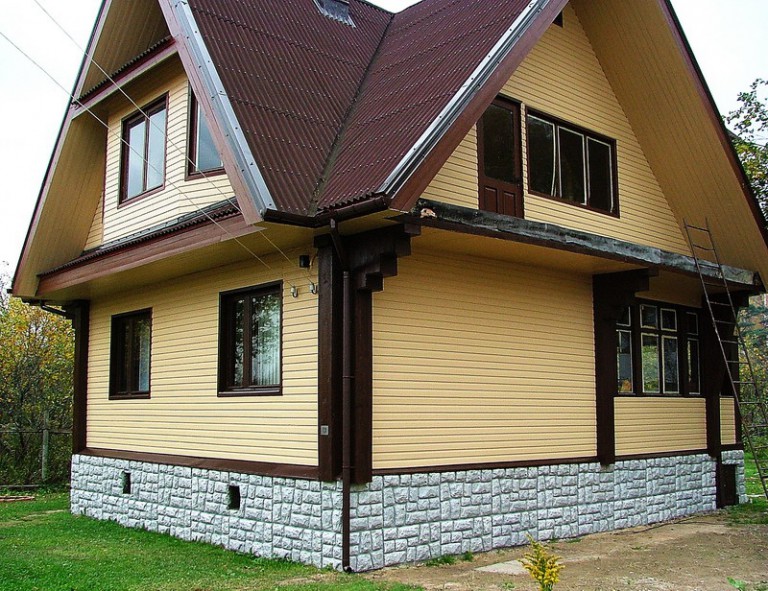
Alas, no comments yet. Be the first!